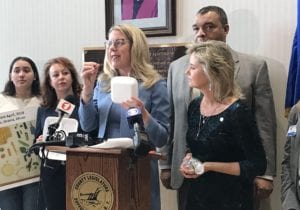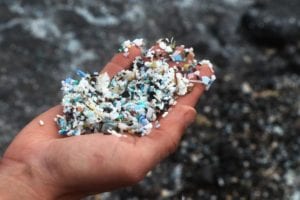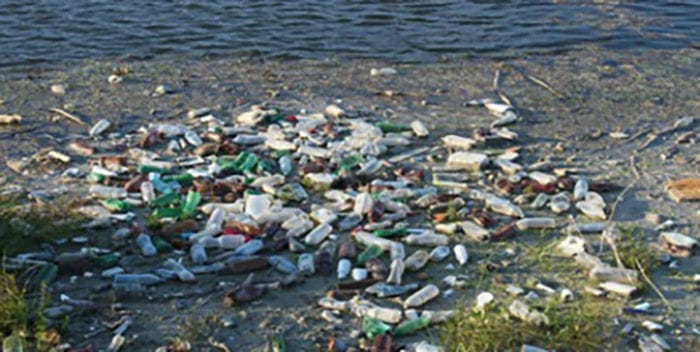By Herb Herman
There appears to be no end to plastic. We use it, live with it, discard it and we can never rid ourselves of the stuff. It comes as food wrappers, bottles, toys, containers of all kinds, and is so pervasive that plastic is very much an omnipresent part of our world.

The numbers are staggering. More than 400 million tons of plastic are produced globally every year. And when we finish with plastic, we throw it out, try to recycle it, hide it in landfills, incinerate it, but, by far, most of the plastic debris we no longer have use for ends up in lakes, waterways and in the ocean. Some 80 percent of this litter comes from land sources, while 60-to-90 percent of beach litter is comprised of plastic. It is not encouraging to learn that Americans use approximately 100 billion single-use plastic bags annually, and around a trillion are used globally. The persistence of plastic waste is legendary, a plastic water bottle lasting 450 years. Much has been written of the plastic floating islands in the Pacific Ocean, and the apparently futile means to get rid of them. The National Geographic pleadingly offers us the “Planet or Plastic?” initiative, but the seemingly endless mass of plastic waste continues to grow like a cancer on the Earth.
If one were to carry out a literature search on plastic waste scientific publications the number of citations would exceed 450,000. The tangible impact of plastic waste is well documented. Most of the articles cited address the problem of plastic distribution around the world, from India to countries in the west, even the Antarctic, and at depths of 6,000 meters in the world’s oceans. Much research concentrates on sea animals and birds the world over, either through ingesting plastic particles or becoming tangled in plastic nets and fishing gear. Many of these plastics break down to fine, toxic particles leaving numerous bird species and sea animals with a high percentage of toxins in their guts.
Crustaceans and fish are well known to consume plastic particles. Since we eat these animals, we also eat plastics. The long-term health consequences of plastic ingestion on sea creatures and humans are still unknown. Enormous quantities of micro-sized particles of plastics from personal hygiene products get deposited in water systems and also float around the world as airborne pollutants. There appears to be no end of plastics in various forms proliferating the earth.
Of course, scientists are constantly seeking solutions. Landfills reach enormous proportions, with no guarantee that the waste plastics thus disposed of will remain where they are placed. Incineration is also used, sometimes to supply energy as a spin-off from the heat produced, but this approach leaves pollutants escaping into the environment. Of course, recycling appears to be the panacea for ridding ourselves of plastic. Unfortunately many plastic materials do not readily lend themselves to this gratifying solution, and recycling depends to a large measure on citizens acting responsibly, collecting candidate plastic products and properly disposing of them. Furthermore, those recyclable plastics that can be conveniently collected and segregated need to be sent to appropriate facilities for processing, and there are far too few of these plants. There will probably never be sufficient numbers of such facilities for the recycling of the vast quantities of plastics, which are continually produced.

What then to do? One can clearly appreciate the great need that exists and the challenges faced by planners and engineers who are tasked with dealing with this overwhelming problem. Academies of sciences and governments the world over have met and discussed this global problem. Some plastic-producing industries have pledged to carry out manufacturing measures and use materials that would ensure plastics can indeed by readily recycled. Governmental organizations have outlawed the use of plastics bags, and even paper straw bans have been introduced. The use of single-use plastic bottles has been vigorously discouraged. Non-governmental organizations have made the public aware of the seriousness of the problem. The list goes on, but millions of tons of plastics continue to be produced annually, and beachgoers continue to use plastic utensils and fail to discard them responsibly.
It is imperative to formulate policies and mechanisms through which plastic litter can be controlled. For starters, the production of biodegradable, nontoxic plastics must be encouraged. A ban on single-use plastic bags should be incorporated in any waste-controlling legislation. Government research funds should be allocated for developing cost-effective chemical and mechanical recycling technologies, and perhaps most important is the education of the public on the matter of plastic’s effect on the marine ecosystem. The time has come to act to save the planet from this scourge of plastic.
Herb Herman is a distinguished professor emeritus from the Department of Materials Science and Engineering at Stony Brook University.











